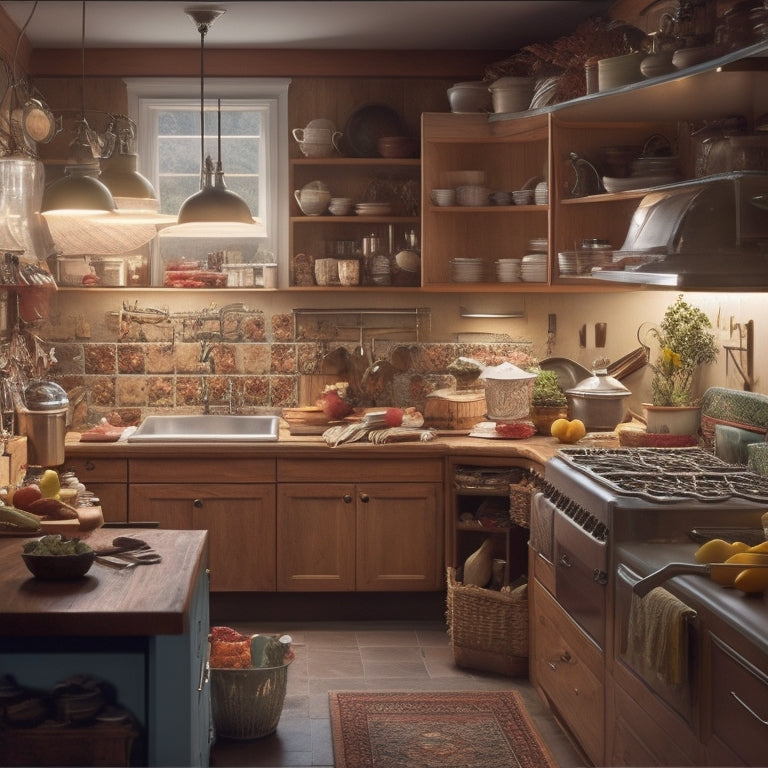
Why Kitchen Organization Remains a Daunting Task
Share
You're likely no stranger to the frustration of a disorganized kitchen, where cluttered countertops, overflowing cabinets, and inefficient storage solutions make meal prep and cooking a stressful ordeal. Kitchen organization remains challenging due to an overwhelming amount of items, limited space and budget constraints, and inefficient use of available space. Clear storage systems are often lacking, and insufficient time for organization only adds to the challenge. Additionally, maintaining an organized space is difficult, and unhealthy habits and clutter tendencies can undermine your efforts. To discover the secrets to a harmonious kitchen, you're just one step away from transforming your cooking haven.
Key Takeaways
• Kitchen organization remains daunting due to the overwhelming amount of items, making it difficult to distinguish essentials from non-essentials.
• Limited space and budget constraints force individuals to prioritize essentials, making organization a constant compromise.
• Inefficient use of available space, such as cluttered countertops, hinders workflow and creates chaos.
• Lack of clear storage systems and inadequate cabinet space leads to clutter buildup and disorganization.
• Unhealthy habits, like emotional attachments and impulse buying, undermine organization efforts, making maintenance a significant challenge.
Overwhelming Amount of Kitchen Items
Your kitchen is likely cluttered with a staggering array of gadgets, cookware, utensils, and food items, making it difficult to pinpoint what you need when you need it. This phenomenon is often referred to as kitchen hoarding, where you've accumulated so many items that it's hard to differentiate between what's essential and what's unnecessary. As a result, you're left with a space that's overwhelming and chaotic.
Item multiplication is a significant contributor to this clutter. You buy one item, and before you know it, you've accumulated multiple versions of the same thing. This can be attributed to factors like impulse buying, lack of storage, or simply not knowing what you already have.
To combat this, it's essential to take a step back and assess your kitchen's current state. Start by categorizing your items into must-haves, nice-to-haves, and items that can be donated or discarded. This exercise will help you identify areas where you can streamline your kitchen's contents, making it more functional and organized.
Limited Space and Budget Constraints
With limited kitchen space and budget constraints, you're forced to prioritize what's truly essential, making every storage decision and purchase a strategic one. You can't afford to waste a single inch or dollar on unnecessary items.
To overcome these challenges, you need to be space savvy and resourceful. Start by identifying the items you use most frequently and allocate prime storage space for them. Consider investing in multi-functional furniture or appliances that serve more than one purpose. For instance, a kitchen cart with built-in storage can provide additional counter space and storage.
To stretch your budget, look for budget hacks like repurposing old items or shopping during sales. You can also get creative with DIY projects, such as upcycling old containers or building your own shelving units.
Inefficient Use of Available Space
As you stand in your kitchen, you're likely surrounded by inefficient use of available space. You're probably guilty of cluttering countertops and shelves with unnecessary items, and neglecting to maximize the potential of corners and cabinets.
Cluttered Countertops and Shelves
Cluttered countertops and shelves are a common kitchen organization pitfall, resulting from inefficient use of available space that hinders your cooking workflow. You're not alone in this struggle.
It's easy to let countertops become cluttered with appliances, utensils, and ingredients, making it difficult to find what you need when you need it. Meanwhile, shelves can quickly become overcrowded, making it hard to access items without creating a mess.
To overcome this challenge, it's essential to implement effective surface styling techniques. Start by grouping similar items together, such as baking supplies or cooking utensils, and assign a designated zone for each group. This will help create a sense of order and make it easier to find what you need.
Additionally, consider using shelf dividers to separate items on your shelves, keeping them organized and preventing clutter from building up. By optimizing your countertops and shelves, you'll be able to cook more efficiently, reduce stress, and create a more enjoyable cooking experience.
Wasted Corner and Cabinet
You're likely sacrificing valuable kitchen real estate by not utilizing the often-wasted corners and cabinets to their full potential, resulting in a frustratingly inefficient use of available space. This oversight can lead to cluttered countertops, crowded shelves, and a generally disorganized kitchen.
By implementing corner solutions and cabinet hacks, you can reveal the hidden potential of your kitchen. Here are some ways to get started:
-
Install rotating corner shelves to maximize storage capacity and accessibility
-
Utilize adjustable cabinet dividers to separate and categorize items
-
Implement a 'lazy Susan' in a hard-to-reach corner to simplify access
- Invest in cabinet organizers with built-in baskets and bins to keep items off the countertops
Lack of Clear Storage Systems
As you stand in your kitchen, you're likely surrounded by cluttered countertops, inadequate cabinet space, and disorganized drawers. You're not alone - a lack of clear storage systems is a common obstacle to achieving the organized kitchen you desire.
Cluttered Countertops Remain
Without a clear storage system, countertops quickly become overwhelmed by appliances, utensils, and gadgets, leaving you scrambling to find space to prepare meals. This creates visual barriers, making it difficult to focus on cooking and creating a sense of chaos in the kitchen. As a result, kitchen dynamics suffer, and meal prep becomes a stressful experience.
Here are some common culprits contributing to cluttered countertops:
-
Coffee makers and toasters: taking up valuable real estate and collecting dust
-
Piles of cookbooks: making it hard to find the recipe you need
-
Mysterious gadgets: forgotten or never used, but still taking up space
- Overflowing utensil holders: making it difficult to find the utensil you need
Inadequate Cabinet Space
Sixty percent of kitchen cabinets are inefficiently utilized, leaving homeowners struggling to find a place to stash their cookware, dinnerware, and food items. You're not alone if you're frustrated with the lack of clear storage systems in your kitchen.
The culprit often lies in the cabinet configuration, which can be a major contributor to the clutter and disorganization.
Custom cabinetry can be a game-changer in optimizing your kitchen's storage capacity. By designing cabinets that cater to your specific needs, you can create a more functional and organized space.
For instance, installing pull-out shelves or Lazy Susans can help you access items that are often hard to reach. You can also consider incorporating dividers or baskets to separate and store items like spices, oils, or cleaning supplies.
Disorganized Drawer Chaos
By opening your kitchen drawers, you're likely to uncover a jumbled mess of utensils, gadgets, and cookware. This disorganized drawer chaos stems from a lack of clear storage systems, making it difficult to find what you need when you need it.
- Utensils tangled together, impossible to separate
- Gadgets and cookware stacked haphazardly, prone to breakage
- Drawer space wasted, with empty areas and overcrowded corners
- Valuable time lost searching for misplaced items
To regain control of your kitchen drawers, it's essential to implement effective storage strategies. One solution is to use drawer dividers, which can separate utensils, gadgets, and cookware into designated areas. This simple yet powerful tool can transform your drawers from chaotic to organized, making meal prep and cooking a more enjoyable experience.
Insufficient Time for Organization
You face a common obstacle when trying to organize your kitchen: you simply don't have enough time to tackle the task. Between work, family, and social commitments, it's easy to let kitchen organization fall by the wayside.
However, effective time management can help you overcome this hurdle. Start by scheduling priorities: dedicate a specific time slot each week to kitchen organization. Even 30 minutes can make a significant difference.
Next, identify the most critical areas of your kitchen that need attention, such as the pantry or countertops. Focus on one area at a time to maintain momentum. Don't try to tackle everything at once, as this can lead to burnout.
Instead, break down larger tasks into smaller, manageable chunks. By doing so, you'll be more likely to stick to your schedule and make consistent progress. Remember, every minute counts, and consistent effort will ultimately lead to a more organized, functional kitchen.
Difficulty Maintaining Organized Space
After investing time and effort into organizing your kitchen, it's frustrating to see clutter and disarray slowly creep back in, threatening to undo all your hard work. You're not alone in this struggle; many people face difficulty in maintaining an organized kitchen space. The key to overcoming this challenge lies in developing personal discipline and habit formation.
To keep your kitchen organized, you need to:
-
Create a routine for cleaning and tidying up after meals
-
Designate a specific place for each item, and make sure everyone in the household knows where things go
-
Set aside time each week to review and adjust your organizational systems
- Make a habit of putting things back in their designated place after use
Unhealthy Habits and Clutter Tendencies
Certain habits and tendencies, such as leaving dirty dishes overnight or accumulating gadgets you rarely use, can undermine your kitchen organization efforts and create clutter hotspots. You mightn't even realize you're doing it, but these habits can quickly snowball into a chaotic kitchen.
Take a step back and assess your habits honestly. Do you have a tendency to hold onto kitchen gadgets or appliances out of emotional attachment, even if you never use them? It's time to let go.
Similarly, are you guilty of mindless consumption, buying kitchen tools or gadgets on impulse without considering whether you truly need them? Break the cycle by being more intentional with your purchases.
Recognizing and addressing these unhealthy habits is essential to achieving a more organized kitchen. By acknowledging your tendencies and making small changes, you can start to break free from the clutter and create a more peaceful, functional space.
It's not about depriving yourself, but about being more thoughtful and intentional in your kitchen habits. With a little self-awareness and discipline, you can overcome these habits and create a kitchen that truly serves you.
Frequently Asked Questions
How Do I Declutter Sentimental Kitchen Items Without Feeling Guilty?
You tackle sentimental kitchen items by acknowledging the emotional attachment, then separate items into keep, donate, and discard piles. Practice memory keeping by taking photos or journaling about each item, allowing you to let go without guilt.
Can a Kitchen Be Organized Without Buying New Storage Systems?
As you gaze around your kitchen, envision a harmonious space where every item has its ideal spot. You can achieve maximum utilization without breaking the bank by creatively repurposing items you already own, like turning mason jars into utensil holders or using a vintage window as a room divider.
Are There Any Free Kitchen Organization Apps or Tools Available?
You'll be delighted to know that yes, there are free kitchen organization apps and tools available! Explore digital decluttering apps like Trello or Habitica, and virtual assistants like Google Keep or AnyList, to get your kitchen organized without breaking the bank.
How Often Should I Reorganize My Kitchen to Maintain Efficiency?
You should reorganize your kitchen every 3-6 months for a Seasonal Refresh, adjusting your layout according to changing Usage Patterns, to maintain efficiency and guarantee your space remains functional and clutter-free.
Can I Hire a Professional Organizer for My Kitchen Only?
"Imagine a superhero cape-clad organizer swooping in to save your kitchen. Yes, you can hire a pro! Expect to pay Organizer Fees ranging from $500 to $2,000, depending on your Kitchen Scope and the organizer's expertise."
Related Posts
-

Newlyweds' Zola Registry: Top Picks Unveiled
Newlyweds can now effortlessly create their dream home with Zola's expertly curated registry picks. For a warm and in...
-

Deighton Associates Awarded for Excellence in Asset Management
You're likely curious about Deighton Associates' recent recognition for excellence in asset management. They've recei...

